
13 minute read
The Bigger Picture
Bill Novelli and Diane Ty walk the halls outside the Business for Impact ofces at Georgetown University’s McDonough School of Business
the supply side, we’re working with key industry players to address portions, starting with the away-fom-home eating space. “Major societal problems can’t be solved by one player or one secor alone ” The AgingWell Hub grew out of a collaboration that started with Philips in 2012, and was ofcially formed in 2015 as part of the White House Conference on Aging. As with the Portion Balance Coalition, we bring together ‘strange bedfellows’ – key players fom diferent sectors, including direct competitors – because we recognize that these major societal problems can’t be solved by one player or one sector alone. For example, I led the development of a Caregiver Journey Map for people taking care of loved ones with Alzheimer’s disease. We created a persona of a woman who was caring for her aging mother and seeing the various stages of the journey fom that caregiver’s perspective. As an ofshoot of the project, we also created an online calculator that calculates the cost of caring for someone with Alzheimer’s at every stage of the journey. The current cost of Alzheimer’s to society in the US is staggering. And more recently, we’re looking to the Journey Map to model the impact of Alzheimer’s on a fnancial caregiver. pectation, for all young Americans. Mahatma Gandhi once observed that the best way to fnd yourself is to lose yourself in the service of others, and that thought is at the heart of what the Service Year Alliance does. The magic really happens when people fom diferent backgrounds come together and work for a common purpose. Our aim is not to mandate a year of service but rather to make it a cultural norm and expectation, so that when people meet one another for the frst time, they might ask “Where did you serve?” – just as we nowadays ask “Where are you fom?” SAL:You’re Senior Project Director of the Portion Balance Coalition and also Director for the AgingWell Hub – two initiatives organized and convened by Business for Impact at the McDonough School of Business. What is the aim of these initiatives, what challenges do they have to overcome and what have they achieved to date? DT: In the Portion Balance Coalition, we’ve brought together representatives fom government, industry, nonproft organizations and academia to address America’s obesity epidemic – with the aim to take this to the rest of the world in the course of time. On the demand side, we are orchestrating a campaign to raise consumer awareness of portion balance – meaning volume, proportionality and quality, and not simply portion control. On
Advertisement
© Susan Bies
Nevertheless, marketing still requires a heavy dose of instinct and common sense. Everything that I’ve done in my marketing career has always been based on consumer insights. What’s different now is that those insights can be gathered and analyzed much more quickly, cost-efectively and in much greater depth.
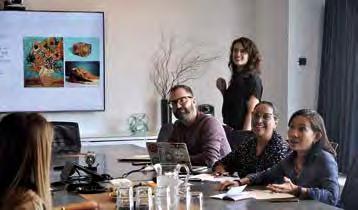
SAL:Bill, you were co-founder and President of the leading PR frm Porter Novelli, for which you worked fom 1972 to 1990. What insights and skills fom this experience do you apply to your wide range of not-for-proft work?
From lef to right: Dena Graham and Nathan Phillips of THAT, Claudia Cukrov and Elisa Silva of SS+K, and Diane Ty discussing creative concepts for the Portion Balance Coalition, a program housed at Georgetown University’s Business for Impact, part of the McDonough School of Business
SAL:The industry use of communication to stimulate societal change is a key theme in your work, Diane, whether at American Express, AARP, Save the Children or, more recently, the McDonough School of Business. In the era of social media, do the new technologies available to us ofer genuinely new ways of engaging and mobilizing mass audiences, or do they mean that we are simply doing old things in new ways, in your opinion?
DT: I think we’re genuinely doing new things. New technologies are making it easier to gauge and mobilize mass audiences. You can come up with more messages more quickly, you can reach a larger audience more cost-efectively, you can share actual content on a massive scale, and almost everyone has a voice now and can express an opinion. All that is positive, but there is a downside too, of course, because digitalization also creates opportunities for misinformation and the feling of strife within society. And none of the new technologies replace the need for face-to-face communication. BN: When Jack Porter and I started Porter Novelli, we moved fom New York City to Washington, DC, to work for the Peace Corps, and then came up with the aim of creating a marketing communications agency there. We thought Washington was all about health and social issues. That shows you how naïve we were! Of course the place is really all about politics, and power, and money, and sex. Anyway, we applied marketing communications to health and social issues, and we created a niche for ourselves, because no one else was doing that at the time. We joined forces with certain academics who were trying to apply the discipline of marketing to social issues and causes, and in the process we pioneered the concept of social marketing. What you’re trying to do in the commercial marketing world is to change the behavior of individuals and to use the marketing mix of Product, Promotion, Place and Price to get a specifc individual to buy a specifc product. I went a long way applying that approach to social marketing, but I eventually found that it’s not enough. You need to change social norms on a huge, environmental level, which means that you have to go beyond the marketing mix and get involved in
SAL:Your background is in marketing: you joined American Express in 1987 and rose to become the company’s Vice President of Marketing. How much of marketing today is science, do you think, how much instinct and how much plain common sense?
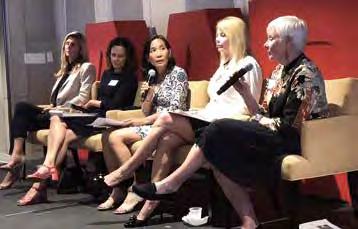
Diane Ty (center) of the AgingWell Hub at Georgetown University’s Business for Impact moderating a panel at the Aging 2.0 event Tale of Two Cities: How Community Impacts Aging, together with (lef to right) Dr Lindsay Mullins of Franciscan Missionaries of Our Lady University, Robin Wagner of Louisiana Department of Health, Gwendolyn Sutton of Virginia Hospital Center, and Gail Kohn of Age-Friendly DC
SAL: You founded Business for Impact at the McDonough School of Business in the belief that “business can be a powerfl force for good,” as stated on the organization’s website. How, in practical terms, do “successfl companies do well by doing good”?
© Business for Impact
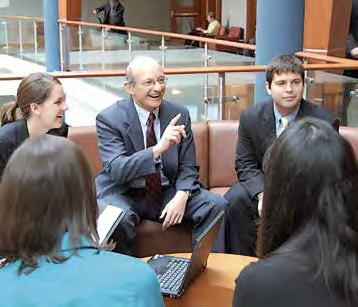
Bill Novelli talking to MBA students about how Business for Impact is working to change the world, by helping companies to do well by doing good
policy advocacy – on the level of legislative, regulatory and even legal advocacy – because policy is the main driver for changing social norms. A good example is the way policy changes have massively driven down the consumption of tobacco. The new communication and information technologies are also important, of course. Likewise important is the role of media, because media can drive social norms. So those are the signifcant learnings fom my days post-Porter Novelli, and I apply them to my current work, which is in the feld of social impact.
BN: Firstly, I would say that “doing well by doing good” is not just about ethical behavior – because everything, actually, has to be about ethical behavior. When you get up in the morning and get dressed and go to work, you have to be legal and ethical. Lots of people say that Corporate Social Responsibility and the Triple Bottom Line of People, Planet and Proft are about ethics, but everything is in fact about ethics. Secondly, I’d like to mention the role of the Anglo-Dutch fast-moving consumer goods company Unilever within the Portion Balance Coalition as epitomizing doing well by doing good. So to my mind, it’s all about companies fnding the ‘sweet spot’ by building environmental, social and governance (ESG) strategies into their core business. If you can do that, you can create greater fnancial value for your stockholders and investors and at the same time create social value for the rest of society.
SAL: Diane, your Ad Council campaign, 'Do Good, Mentor a Child' won an Efe Award when you were working at Save the Children. What is the essence of a good advertising campaign?
DT: I think it starts with a very strong emotional connection to the audience. Then you need a clear call to action: what do you want people to do? And the third component is the ability to measure results. A great advertising campaign is all well and good, but did it actually achieve what it set out to do? We ap-
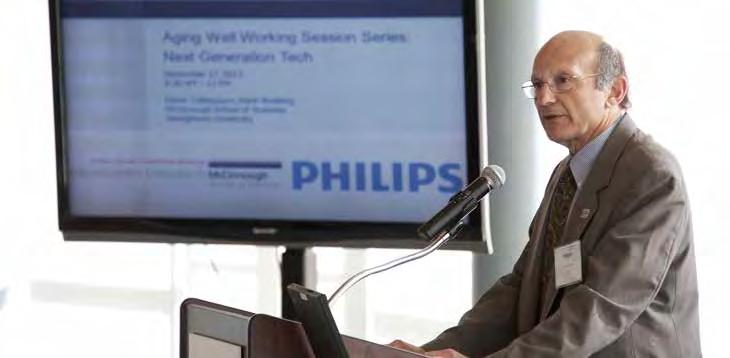
plied those criteria to the ‘Do Good: Mentor a Child’ campaign, which was all about encouraging adults to volunteer to spend quality time with a child in their community, letting that child know there was a caring adult other than a parent or guardian in their lives.
SAL: The world remains fascinated with the perceived glamour of public relations, marketing and advertising – as witness, for instance, AMC’s award-winning 2007–2015 TV series Mad Men, which is set primarily in a fctional advertising agency on Madison Avenue in Manhattan, New York City, during the 1960s. Are these disciplines as glamorous as they are sometimes perceived to be, and does advertising still have the power it used to have in the ‘golden days’ of Madison Avenue?
DT: I think that the work done by advertising is still really important and powerfl, but there have been two big changes since the days of Mad Men. One is the huge amount of industry consolidation that has taken place, and the other is the shif to online advertising, with data scientists now in the mix. We can now target audiences more precisely than ever before and use real-time analytics to assess the efectiveness of advertising initiatives. Creatives have much more powerfl tools at their fngertips; and at agencies, there’s still a need for strong strategy and relationship management skills, and for good leadership. And of course, there are many more opportunities for women and for people of color. BN: I think ethics and social responsibility are important for everybody. I run a program on ethical leadership here at Georgetown in which we ask the questions: “What is leadership?” and “What is ethics?” All the world’s great religions, of course, have the same premise, which is the Golden Rule: Treat other people as you would have them treat you. Our society is currently wrestling with the question, “What is ethical behavior?” – and it’s a question we have to ask ourselves every day.
SAL: ‘Hands-on service’ is key to the work of the Service Year Alliance, Diane. Is there a fgure, real or fctional, who has particularly inspired you in your commitment to give something back to society?
DT: I don’t think I could point to a particular person, but events experienced as a child have certainly shaped my worldview. My parents are of Chinese origin and come fom the Philippines. I was very struck by the poverty I witnessed when visiting the Philippines together with my parents at the age of 12. It made me feel that I should work not just for fnancial gain but for a real purpose, and this experience has inspired my whole career in the nonproft sector. That’s how I met Bill, of course, and I continue to meet inspiring people along the way. Service works!
Bill Novelli and Diane Ty were interviewed by Jonathan Stefen
SAL: Bill, you have had leading roles in international relief and development (with CARE), ethical campaigning (Campaign for Tobacco-Free Kids) and improving people’s quality of life as they age (AARP). What drives you to devote so much energy and professional expertise to these and other social initiatives?
Further information
Business for Impact > businessforimpact.georgetown.edu
Portion Balance Coalition > portionbalance.org
AgingWell Hub > www.agingwellhub.org
For a world freefrom malnutrition.
Connect with us!
@sightandlife @sightandlife sight-and-life @sightandlife
Refecions fom Andrew Shao Remembering Dr John Hathcoc
This obituary was originally published on 30 April 2019 by CRN (www.crnusa.org/Shao-on-Hathcock-2019). Reproduced with permission.
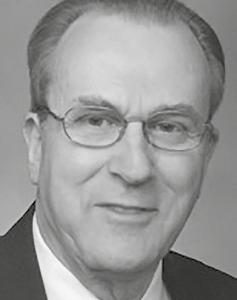
Dr John Hathcock John was a prolifc author ofpeerreviewed, publishedscientifc articles. It’s hard to know for sure, since there are other ‘J Hathcock’ authors, but my estimate is close to 100 peer-reviewed articles in PubMed. Many of them, of course, focused on his passion: Use of risk assessment to establish science-based maximums for nutrients (and bioactives). Between 2006 and 2013, John and I were co-authors on 10 publications, mostly focused on risk assessment. I was never more productive in terms of publishing than during that time when I worked with John. He was the master mentor, and I was the eager student, and I believe we formed the most prolifc tandem CRN – or any other supplement association – has ever experienced, or will ever experience. Our work is still to this day referenced by companies and governments, and served as the basis of many IADSA documents and guidelines used throughout the world. “John was a maser mentor” Hathcock’s Observed Safe Level method now recognized by WHO John’s concept that he called “Observed Safe Level” – or OSL – was revolutionary and preceded any formal recognition by many years. John frst came up with the term when authoring CRN’s frst edition of the Vitamin & Mineral Safety book. It was meant to address those nutrients for which there was ample safety data, but for which no Upper Level (UL) could be derived. For some nutrients, without a hazard, or identifcation of an adverse efect, by defnition, no UL could be derived. The absence of a UL for nutrients such as vitamin B₁₂ was misconstrued by some governments as lack of safety data – and license to apply the precautionary principle, setting maximums based on RDA multiples. But B₁₂ has lots of safety data, just no toxicity. So rather than having no UL (or no number), John proposed the “OSL” – a value representative of studies that had been conducted on a nutrient for which no toxicity had been observed. “Governments all over the world now use John’s approac ” Other governments followed this (for example, the UK, with a B₁₂ ‘guidance level’) and in 2006, the World Health Organization (WHO) formally recognized this approach but used a diferent term: ‘Highest Observed Intake’ or HOI. Although John was clearly the pioneer of this approach, he never received formal recognition or credit fom any government body or organization for this. Still, being John, he was never concerned with getting credit; he only cared that folks fnally got it right. Now governments all over the world use this approach. In addition to its use for policymaking with nutrients, the OSL/HOI approach is being applied to bioactives, as well, following some additional eforts of ours. Similar to B₁₂, many bioactives have been studied at high doses, but no toxicity has been observed in humans so a UL cannot be established. I’m so proud to have had the opportunity to work with, and be mentored by, John. Andrew Shao PhD, Interim Senior Vice President, Scientifc & Regulatory Afairs, Council for Responsible Nutrition (CRN), Washington, DC, USA









